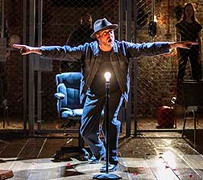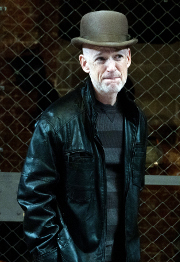
Two Views of "The
Resistible Rise of Arturo Ui"
Lucy Komisar
Ed Rubin
|
Fine Raúl Esparza as gangster/Nazi in Brecht’s powerful allegory “Arturo Ui”
Bertolt Brecht’s brilliant 1941 allegory of fascism and the rise of Hitler, “The Resistible Rise of Arturo Ui,” is set in a Chicago that appears helpless to ward off gangsters. A good choice since Al Capone ran the mob for so long there in part by paying off police and politicians. In this satire, the gang is taking over the city’s cauliflower business, strong-arming merchants into making them “partners.”
The cauliflower merchants represent the petite bourgeoisie in Germany who supported Hitler. We see as Arturo Ui (the extraordinary Raúl Esparza), morphs into Hitler, in voice and gesture, how some targets fight, some are destroyed and others succumb. His is a bravura performance. John Doyle directs a very good minimalist production, with actors waiting behind a chain-link fence so you get the sense that all the characters are always there. Brecht wrote this as a refugee, while Hitler was rampaging in Europe. He describes the rise of Hitler in a way Americans can understand as a small-time crook/thief/conman using thuggish violence to attack small merchants. He also shows Ui’s/Hitler’s attack on the working class. Esparza has kept the fast-talking speech and accent from Ui’s native Brooklyn as he scopes out his assault on Chicago. He’s a lowlife, but Brecht ironically mixes Shakespearean language, couplets, mood, with references to the great plays, and to the brutality that infused many of them. “Where are the goons of yesteryear?” The time is 1929-32. Germany landowners wanted government subsidies. Workers are agitating for higher wages. But maybe stores will be smashed. Grocers will want protection – at a modest fee. And if you are on the right side, a loan is given to a cousin who embezzles it.
1932 is the year of the Nazi burning of the Reichstag. We hear the shouts of the Hitler crowds. Accusations that the perpetrators are paid by Moscow gold. (Sound familiar today?) Brecht moves through those years to show the failures of German politicians. In fact, the major corporate interests supported Hitler’s rise to power. In 1933, Hindenburg yields to Hitler. He is represented by Dogsborough (Christopher Gurr), the local party boss, who gives up his job to Ui. Ui appears with a sheet like a toga, in a speech that starts like Caesar. “Who is for me?” Then erupts into fury like Hitler, face twisted, the heil salute. The only downside of this very fine production is that if you are sitting on one of the sides of the three-sided theater, it is hard to understand actors whose backs are to you.
The Resistible Rise of Arturo Ui
“The
Resistible Rise of Arturo Ui" “Every day I read the play, I think, I hear the words these
words on CNN as I read them on the page. The play will be falling
right around the midterm elections, and it is fitting that it reminds
us of the choices that are available to us in relation to the way
the world can go. That really is the foundation of what classical
theater says. Classic plays have politics at their heart-you take
a play like Richard III or the Scottish Play—they’re
warnings. And there’s a warning in Arturo Ui. This is a time
for theater to say something; if we’re not screaming and shouting
now, when are we ever going to do it?” For those who love the work being done at the Classic Stage Company and Bertolt Brecht, both of which I do, you had better run to see "The Resistible Rise of Arturo Ui," as its curtain goes down on Saturday, December 22, 2018. Written in 1941, when Brecht was living in exile in Helsinki, Finland, just before he decamped to Hollywood, the play chronicles the rise of Arturo Ui a fictional 1930s Capone-like Chicago mobster and his ruthless attempts to control the cauliflower market by forcefully selling protection to business owners, ironically from his own men. A satirical allegory with vaudevillian overtones, clever word-play, and numerous quotes from Shakespeare’s Hamlet and Richard III, many in verse, ‘Arturo Ui’ closely follows Hitler’s rise to power in Germany and the advent of the Nationalist Socialist state. Brecht being a Marxist at heart, lightly buried within the plot’s heavy mix of murder and mayhem, is an attack on the evils of capitalism. The most compelling conceit of this play is that all of the play’s characters, events, groups, and locations, with Arturo Ui (Raúl Esparza) representing Hitler, have direct counterparts in real life. However, if you don’t know the history of pre-World War II Germany like the back of your hand it is not easy to identify, other than Esparza’s Hitler, which actor is representing Joseph Goebbels (Propaganda Minister), Hermann Göring, Ernest Rohm (Commander of SA, the Nazi’s party militia), Paul von Hindenburg (President of the Weimar Republic), and Engelbert Dollfuss, the assassinated Chancellor of Austria. Though the audience could access the play’s program using their smart phone to read what is what and who is who – which few people seemed to be doing – no Playbill was handed out to the theatre’s patrons. A barrage of complaints about this, among both the audience and attending critics, entered my highly-attuned ear, before the play started, and after it ended. Hopefully this is a one-off deal, and the Classic Stage Company will rethink this unwelcomed practice. In all fairness, some of this where, what, how and who confusion is somewhat alleviated by a loudspeaker announcing what historical event, along with the year, had just taken place in Germany. The first of some ten announcements tells us that the year was 1932, there was a worldwide slump, Germany was hit hard, and that the Prussian landowners were angling for a government subsidy. The last two announcements informed us that in 1938 the Nazi’s invaded Austria and that 98% of the Terrorized Electorate voted yes for Hitler becoming the supreme commander. All ten Brechtian flavored scenes, fraught with lying, deceit, arson, theft, and murder, and more than a dollop of cleverly sharpened humor tossed about many of the play’s characters, begins to unfold after each broadcast. While the city of Chicago representing Berlin is a no brainer, even for the novice, identifying the other locations is more difficult. For the record, in this play Cicero is Austria, the burning Warehouse is the Reichstag, and the Trust, which initially one is led to believe has all of the power, are the Prussian nobility who owned the great estates that were maintained and worked by peasants. Not that any of the above is absolutely necessary to know in order to enjoy the play, as we do recognize the actions of each character, and a City is a City. Of course this ‘distancing effect’ is exactly Brecht’s intention, as the playwright was far was less interested in the audience actually identifying emotionally with the characters, or even the play’s location, which theoretically could be anyone and anywhere. What he most wanted was the audience to recognize the social injustice and exploitation happening right in front of them and to be moved enough to go forth from the theater and effect change in the world outside. Interestingly enough, this is exactly what TV newscaster Howard Beale (currently being channeled to a Tony-smelling fare thee well by Brian Cranston in the Broadway production of Network) wants when he urges his viewers to lean out their windows and yell, “I’m mad as hell and I’m not going to take it anymore.” If that is not sufficient enough to raise ones hackles the theater audience is instructed, a number of times during the play, to shout this same saying out loud, leaving no doubt in anybody’s mind that Trump and his continuously changing circle of appointees were its main targets.
As with many of the today’s plays, whether classical, contemporary,
comedy or drama, the ‘Elephant in the Room’ lurking
about, not unlike his creepy behavior during his debates with Hillary
Clinton, is the Ghost of Trump. Here too one cannot sit through
‘Arturo Ui’ without thinking about the rise of Trump
and the politically divisive world that we are now living in. Towards
the end of the play, Doyle, gilding the lily, links the past to
our present by bombarding the audience with the sound of crowds
shouting “Sieg Heil” “Sieg Heil”, over and
over again. Quite unexpectedly these shouts morphs into Trump supporters
chanting “Lock Her Up!, Lock Her Up!, Lock Her Up.”
The last Bertolt Brecht play that I saw was also at the Classic Stage Company. If memory serves me, the play, also directed by John Doyle in 2010, was simply wonderful all the way around. The acting, the direction, the set, the lighting and costumes, was all of one piece. If it was a cake, it rose perfectly. It tasted delicious. And everybody got several pieces to take home. Not so with CSC’s current production of The Resistible Rise of Arturo Ui. Though it was an admirable attempt, the cake here did not rise to the occasion. The big spoiler was the set which placed the play’s eight actors, often in complete darkness, behind an industrial steel fence in the rear of the space where they waited until needed to come to the stage. These excessive comings and goings, and the clanging metal gate, as the actors entered and exited, quickly grew tiresome. While Ann Hould-Ward’s casual, dress-down costuming was nearly letter perfect, Jane Cox’s extremely low lighting, totally erasing the actors from view in some scenes, did nobody, audience and actors alike, any favors.
Strangely, the actor that commanded the most attention, and was afforded the most stage time, other than Esparza, was actor Christopher Gurr who as Dogsborough (in real life was Paul von Hindenburg the President of Germany during the twenties and thirties). As the well-respected bedrock of Chicago businessmen, the very man that Ui, first turned for help on his way up the gangster ladder, his character – the only one in the play that realistically takes us under his skin - was the one most interesting to watch. Inexplicably, Gurr’s acting, compelling to watch, was not in the least Brechtian in style. Other actors, some playing more than one role, and many of these are supporting cameos, peopled the stage like insects coming and going. As far as Esparza, his portrayal of Ui, for some reason or other – maybe it was an off night – was less than satisfactory. His quiet moments were bland, and his handling of Ui’s most turbulently moments, which should have been bigger than life, perhaps even other worldly in its effect, were unbelievable. That is to say his acting was a lot more Esparza and a lot less Ui. Of course, there are a few scenes in which the actors burst into flame. The most entertaining, both scary and funny in its truthfulness, takes place right after an announcement from the loudspeaker tells us that it is 1933 and Hindenburg yields to Herr Hitler and Hitler is the new head the new government.” It is here that Esparza’s Ui, wanting to change his image to fit his new role as a more powerful boss, gets to flex his comedic muscles. Deciding that he needs to know how to speechify, walk, and sit in order to become the big boss, he asks “How d’you guys walk around in the theater or the opera,” The assignment to bring him up to snuff quickly falls to a quirky has-been actress, beautifully played by Elizabeth A. Stanley. Adopting the air of a Shakespearian Tragedian her tutelage begins with her telling Ui that he has come to the right place and that she can teach him, “the grand manner in ten minutes.” And teach him she does. With every bodily movement she suggests, each one crazier then
the next, we watch, as Ui goes from a simple boy from Brooklyn,
as he likes to say throughout the play, to a robotic-like creature
not too far removed from Chaplin’s performance in the 1940
film The Great Dictator. “Hold you head up! Let your toes
touch the ground first,” she counsels. “You have a natural
talent except you don’t know what to do with your hands. It
might be best if you place them in front of your genitals”
she adds. As far as sitting Ui is advised to “Put your hand
on your thighs, parallel to the stomach, always away from the body.”
Of course, all of this vaudevillian schtick, nicely played out by
Esparza, elicits waves of laughter from the audience. When asked
by one of his cohorts if he is trying to impress the high-hats in
the Trust, Ui answers, “Naturally not, I’m doing it
for all them little people…who the hell cares what professors
think. Or city-slickers, intellectuals. What counts is what the
little hick.” I ask you, does any of this sound familiar?
|
| museums | NYTW mail | recordings | coupons | publications | classified |





